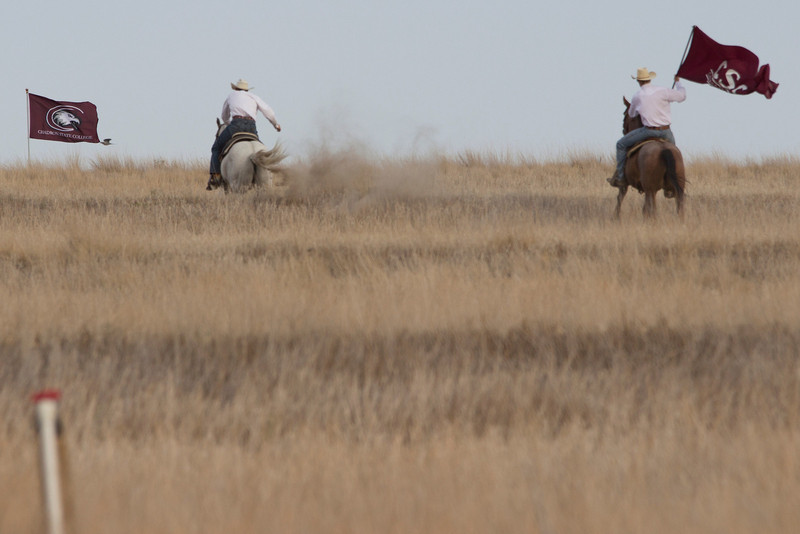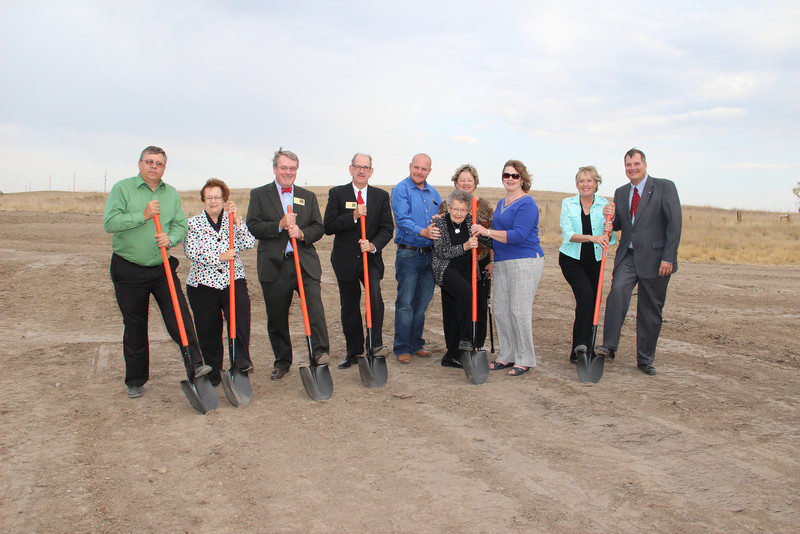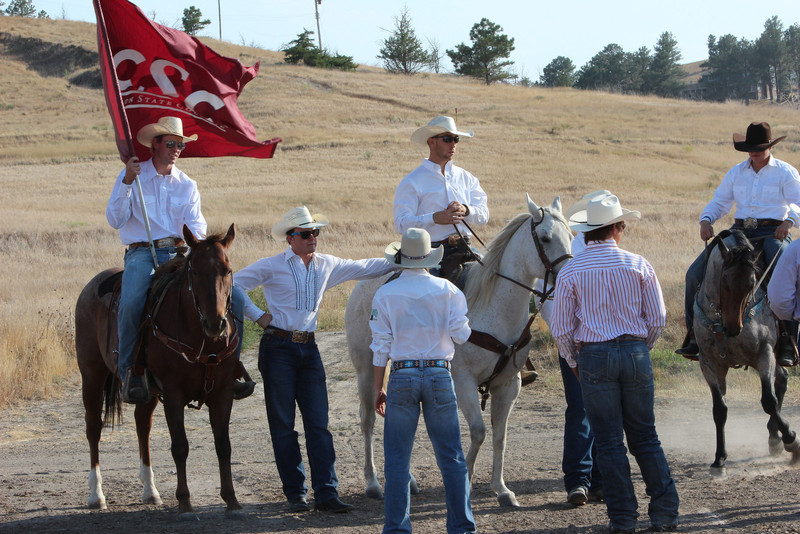Blazing trails: College breaks ground on Rangeland Complex

And, they’re off.
In a ceremony that involved charging horseback riders on the windy prairie, Chadron State College marked the beginning of construction for the Rangeland Complex on Thursday, Sept. 6.
About 200 people gathered on the east side of campus for the ceremonial groundbreaking of the $2.9 million first phase of the new facility, which will serve CSC’s programs for rangeland management and agriculture.
While the event featured the obligatory photo op with shovels, a part of the ceremony that was uniquely western drew applause.
Prompted by Interim President Dr. Randy Rhine, three members of the Chadron State College rodeo club – Bridger Chytka, Collin Chytka and Kelsey Scott -- helped kick off the ceremony by charging the nearby hilltop on horseback. One of the riders carried a CSC flag to the spot east of the CSC Softball Field parking lot where the facility will be constructed.
The Rangeland Complex is one of three new construction projects that will soon begin at CSC. It, along with new housing units on the east side of campus and the first phase of renovation and expansion of the Armstrong Physical Education Building, will total more than $19 million. The first phase of the Rangeland Complex includes an indoor arena, along with the extension of 12th street, utilities and other infrastructure.
“While it’s exciting to see these projects begin, we know that they will eventually allow us to serve our students better,” Rhine said. “It is also rewarding to know that they will create a flurry of economic activity for the community and the region for a number of years to come.”
The half-hour ceremony included comments from CSC officials and others who have been involved with the project.
Stan Carpenter, chancellor of the Nebraska State College System, spoke about the value of CSC’s rangeland management offerings and commended it for being the second largest such program in the nation.
“We don’t break ground in the State College System very often,” Carpenter said. “This rangeland program at Chadron is one that is unique and one that is important to the college, to the region, to the state and to all who live in northwest Nebraska,” he said.
Carpenter also expressed assurance in the eventual completion of the project’s $3.5 million second phase.
“When we get this first phase done, I am confident that we will find funding to begin the second phase of this project because it is so very important to this college and this area.”
Dr. Chuck Butterfield, who serves as chairman of CSC Department of Applied Sciences and teaches rangeland management courses, related the importance of agricultural offerings to the region and told about his department’s make-up and history. He described the project as a team effort that has come far, recalling a meeting with CSC administrators that he and fellow professor Georgia Younglove attended in 2002 to begin discussing the possibility of an arena.
Butterfield noted that courses in general agriculture, agronomy and soils were among the first classes offered when the college was established in 1911. Soon after, in 1917, the college added a department of agriculture and the institution’s first livestock courses. He talked about a number of ups and downs in the program, with the addition of a rodeo team in 1955 among the milestones.
“This is a great opportunity for our program. Half of this state is rangeland. We’re out here in the heart of range country,” Butterfield said.
One of the speakers, Chadron State Foundation board chairman Fran Grimes, said she became a true believer when Butterfield led her and others on a tour of the Department of Applied Sciences’ current arrangement in the Burkhiser Complex.
“I was surprised at the inadequacy of these facilities,” she said. “This turned me into a true believer that the rangeland agriculture Center and Pavilion is not just a worthy project, but that it is greatly needed.”
The Rangeland Complex is heavily funded by the private contributions of Vision 2011, a fundraising effort by the foundation. Grimes expressed gratitude to all of the project’s supporters, including 20 major donors.
Grimes noted that Vision 2011 raised $1.5 million for the Rangeland Complex through December 2011. She also pointed out the $1 million rural development loan made possible by the USDA and the Panhandle Rural Electric Membership Association.
Among the members of the audience who received special acknowledgement were longtime CSC supporter Virginia Coffee of Harrison and members of her family. Rhine announced that members of the Nebraska State College System Board of Trustees, who attended the ceremony, were scheduled to take action on naming the arena the “Coffee Agriculture Pavilion” the following morning.
Many of the speakers gave credit to Dr. Janie Park, retired CSC president, who came from Montana to attend the ceremony.
“Janie had a big role in working with the foundation and our supporters to make this day happen,” Rhine said.
Chadron Mayor Karin Fischer spoke about the ongoing partnership between City of Chadron and CSC, noting that the facility will help ensure and improve that relationship.
Joel Hyer, the CSC dean who oversees Applied Sciences, related the Rangeland Complex to the institution’s identity.
“One of the larger issues in higher education today is the struggle for institutions to figure out who they are,” he said. “Identity. Character. There might be many colleges and universities that grapple with this. I would suggest that Chadron State College is not.”
Dr. Charles Snare, CSC vice president for academic affairs, recited a quote from Charles Dickens to characterize the project:
“The whole difference between construction and creation is exactly this: that a thing constructed can only be loved after it is constructed; but a thing created is loved before it exists.”
Rhine opened the ceremony by relating the event to the wildfires that burned more than 165,000 during the past week.
“It’s timely that we’re breaking ground on this project today after the wildfires of last week,” he said. “They were events that reminded us of the power of nature and its ability to trump us, the greatness in the hearts of our neighbors who risked life and limb to battle the blazes, and the importance of understanding the rangeland we call home.”
Category: Campus Events, Campus News, Historical, Range Management



